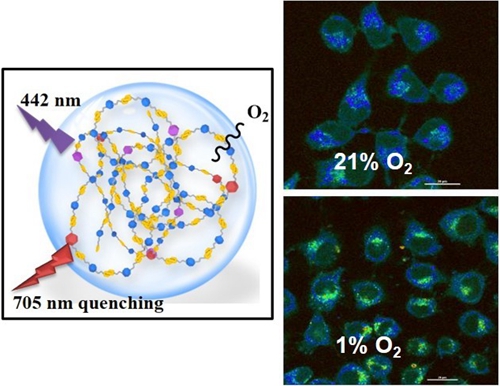Oxygen (O2) plays a crucial role in many physiological and pathological processes in biological systems. Oxygen deprivation has been found to be connected with a variety of diseases, such as cancer growth and neurological disorders. Thus, the measurement and imaging of oxygen levels in living cells and tissue are critical to diagnosing cancer, understanding cellular function, and probing etiology of these diseases.
CHEN yuzhe and co-workers in the Technical Institute of Physics and Chemistry, Chinese Academy of Sciences reported the first example of a water- dispersible, ratiometric luminescent nanoprobe, comprised of a hydrogen-bonded supramolecular polymer for oxygen sensing in living cells. The supramolecular polymer based nanoprobe (SPNP) is prepared from the co-assembly of a bis-ureidopyrimidinone (bis-UPy) -containing phosphorescent indicator, fluorescent reference dye, and skeleton unit through quadruple hydrogen bonds by a mini-emulsion method. The nanoprobe is highly sensitive to oxygen, exhibiting reversibility, excellent storage stability and photostability, good cell-penetrating ability, and low cytotoxicity toward living cells. This work is expected to lead to the design of other SPNP for other important analytes in biological systems.(Adv. Funct. Mater. 2016, 26, 5419–5425, Back Cover)
http://onlinelibrary.wiley.com/doi/10.1002/adfm.201601831/full A Hydrogen-Bonded Supramolecular Polymer-Based Nanoprobe for Ratiometric Oxygen Sensing in Living Cells

Supramolecular polymer based oxygen nanoprobe( Image by CHEN yuzhe)
NEWS